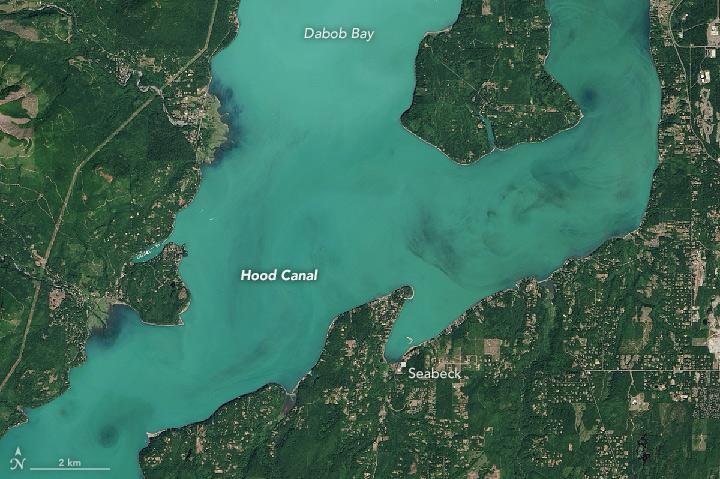1 of 2 | A phytoplankton bloom in a sliver of the Puget Sound has turned the water a milky turquoise color. Photo by NASA/EO/MODIS/Aqua
SEATTLE, July 29 (UPI) -- Prime phytoplankton conditions have coalesced in a slim finger of the Puget Sound, encouraging an explosion of microorganisms that's turned the water a milky turquoise.
The bloom of phytoplankton is concentrated in a fjord that snakes off the southeast corner of the Puget Sound called Hood Canal. Earlier this week, the Moderate Resolution Imaging Spectroradiometer on NASA's Aqua satellite snapped a natural-color photograph of the phenomenon from 436 miles above.
Though not as obvious, the color change is noticeable from ground level, too. Some Washington residents may think they've been transported to the Caribbean as they look out across Hood Canal.
Phytoplankton blooms aren't uncommon in Hood Canal, where a combination of warm water and sunny weather allow microorganisms to thrive.
"It has also been very sunny lately, so that begets blooms," Jan Newton, an oceanographer at the University of Washington, told NASA's Earth Observatory.
Though phytoplankton explosions aren't typically as problematic as toxic algae blooms, they can cause similar conditions -- like hypoxia, a rapid reduction in dissolved oxygen.
Researchers are closely monitoring the situation, with hopes that the bloom won't interfere with oyster spawning season, which is expected to begin shortly.
As Teri King of Washington Sea Grant explained, the milky white appearance is caused by the calcium carbonate in the plates of coccolithophore, a type of unicellular, eukaryotic phytoplankton.
"It is hard to miss a bloom of this color," King wrote in a Facebook post. "We don't see them often, but when we do it is remarkable. The water takes on a tropical blue green appearance with white speckles."















